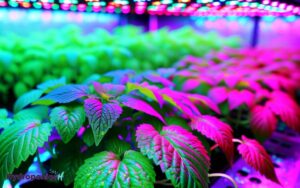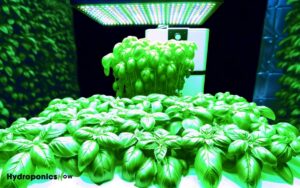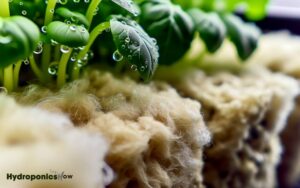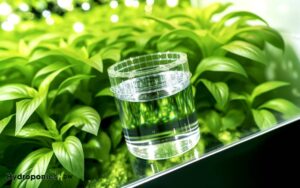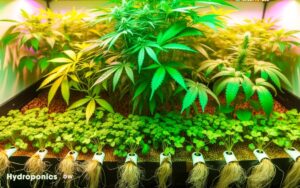Top 7 Best Air Diffuser Types for Hydroponics in 2024
For peak performance in hydroponic systems, the top air diffusers are ceramic and rubber membrane types.
Ceramic air diffusers excel due to their fine porous structure, ensuring ultra-fine bubble production and high oxygen dissolution.
Rubber membrane diffusers offer durable elastomer construction with micro-perforations that maximize gas exchange efficiency and uniform oxygen distribution.
Both types greatly enhance root respiration and plant health. Additionally, nano bubble diffusers, with their ability to generate ultra-fine bubbles, provide superior gas-liquid interface areas, essential for maximizing plant growth rates.
Exploring these options will further elucidate which attributes align best with your specific hydroponic needs. Understanding these attributes will help you maintain an efficient and productive system while minimizing potential issues. Factors such as nutrient balance, water circulation, and how often to clean hydroponics setups all play a crucial role in achieving optimal plant growth. By assessing these elements, you can tailor your approach to ensure long-term success.

Key Takeaways
Stone Air Diffusers
Stone air diffusers, commonly composed of porous materials such as ceramic or sintered glass, are integral components in hydroponic systems for optimizing oxygen diffusion and enhancing root respiration.
Their microporous structure facilitates the production of fine air bubbles, increasing the surface area for gas exchange.
This efficiency in oxygenation directly impacts root health, promoting robust growth and nutrient uptake. The durability of these materials guarantees consistent performance, while their chemical inertness prevents contamination of the nutrient solution.
Precision in pore size distribution is critical, as it dictates the bubble size and the overall effectiveness of oxygen transfer.
Understanding the material properties and their interaction with hydroponic solutions is essential for selecting an appropriate stone air diffuser to maximize system efficiency.
Ceramic Air Diffusers
Ceramic air diffusers, renowned for their microstructural integrity and high thermal stability, play a crucial role in enhancing oxygen distribution within hydroponic systems.
These diffusers utilize fine porous ceramic materials that generate ultra-fine bubbles, facilitating superior gas exchange efficiency.
The high surface area-to-volume ratio of these microbubbles guarantees the ideal dissolution of oxygen into the nutrient solution, greatly improving root respiration and overall plant health.
Moreover, the durability and resistance to chemical degradation of ceramic materials prolong the lifespan of the diffuser, making it a cost-effective choice for long-term hydroponic operations.
Their ability to maintain consistent performance under variable temperature and pressure conditions underscores their indispensability in precision-driven horticultural applications.
Rubber Membrane Diffusers
Moreover, rubber membrane diffusers are pivotal in hydroponic systems for their efficient oxygen distribution, which optimizes plant root respiration and nutrient absorption.
Constructed from durable elastomeric materials, these diffusers offer long-term reliability and resistance to wear and biofouling.
Moreover, their design facilitates easy maintenance procedures, reducing operational downtime and ensuring consistent aeration performance.
Efficient Oxygen Distribution
Guaranteeing ideal oxygen distribution in hydroponic systems, rubber membrane diffusers utilize fine perforations to create microbubbles, thereby maximizing the surface area for gas exchange.
This design ensures an efficient transfer of dissolved oxygen (DO) into the nutrient solution, which is crucial for ideal root respiration and nutrient uptake.
The microbubble generation facilitates a uniform oxygen distribution, minimizing hypoxic zones within the root zone. Additionally, the small bubble size increases the retention time of oxygen in the solution, enhancing its absorption rate.
Advanced studies have demonstrated that rubber membrane diffusers achieve higher oxygen transfer efficiency (OTE) compared to other types of diffusers, making them indispensable in maintaining a highly aerobic environment conducive to robust plant growth and development.
Durable Construction Materials
The longevity and reliability of rubber membrane diffusers in hydroponic systems are primarily attributed to their construction from high-grade elastomer compounds.
These compounds offer exceptional resistance to chemical degradation and mechanical wear. The elastomers are engineered to withstand prolonged exposure to nutrient solutions, pH variations, and biofilm accumulation without compromising structural integrity.
The microporous design of rubber membranes ensures uniform bubble formation, optimizing oxygen diffusion and enhancing root zone aeration.
Additionally, the inherent flexibility of elastomer compounds allows the membrane to endure repetitive strain from air pressure fluctuations, preventing cracks and tears.
This durability is essential for maintaining consistent performance, reducing the frequency of replacements, and ensuring the long-term sustainability of hydroponic operations.
Easy Maintenance Procedures
Regular maintenance of rubber membrane diffusers involves systematic procedures that guarantee peak performance and longevity in hydroponic systems.
This process typically includes routine inspection for biofouling, physical damage, and membrane clogging. Cleaning should be performed using mild acid solutions or enzymatic cleaners to remove organic deposits effectively, ensuring maximum oxygen transfer efficiency.
Periodic backwashing with clean water can also prevent particulate buildup. Additionally, monitoring air pressure and flow rates is critical; deviations can indicate membrane wear or obstruction.
Replacing worn-out membranes at regular intervals is essential to maintain system efficacy. By adhering to these maintenance protocols, cultivators can secure sustained aeration performance, thereby enhancing nutrient uptake and plant growth in hydroponic setups.
Flexible Air Diffusers
Flexible air diffusers, constructed from pliable materials such as silicone or rubber, offer enhanced adaptability in hydroponic systems by conforming to various reservoir shapes and sizes.
These diffusers guarantee uniform distribution of dissolved oxygen, which is crucial for root health and nutrient uptake.
The flexibility of the materials allows for easy installation and repositioning, minimizing disruption to the root zone. Additionally, their resistance to clogging and biofouling extends their operational lifespan.
Below is a comparison of key characteristics:
| Feature | Flexible Air Diffusers |
|---|---|
| Material | Silicone, Rubber |
| Adaptability | High |
| Installation Ease | Simple |
| Maintenance Frequency | Low |
| Lifespan | Extended due to flexibility |
This adaptability makes them a top choice for dynamic hydroponic setups.
Glass-Bonded Silica Diffusers
Engineered for durability and high performance, glass-bonded silica diffusers provide exceptional aeration efficiency in hydroponic systems.
These diffusers are constructed from finely milled silica particles fused together at high temperatures, resulting in a robust, porous structure.
This unique composition allows for the production of ultra-fine bubbles, which greatly enhance oxygen transfer rates and nutrient uptake by plant roots.
The inherent chemical inertness of silica guarantees no adverse reactions with nutrient solutions, maintaining the ideal pH levels essential for plant health.
Additionally, their resistance to clogging and ease of cleaning extend the operational lifespan, reducing maintenance costs. These properties make glass-bonded silica diffusers a preferred choice for growers seeking to maximize growth rates and overall crop yield.
Stainless Steel Diffusers
Moreover, stainless steel diffusers are renowned for their exceptional durability and longevity, providing a robust solution for hydroponic systems. Their design facilitates superior oxygen distribution efficiency, optimizing dissolved oxygen levels for enhanced plant growth.
Moreover, these diffusers feature a low-maintenance profile and are resistant to biofouling, ensuring ease of cleaning and sustained performance.
Durability and Longevity
Owing to their exceptional resistance to corrosion and mechanical wear, stainless steel diffusers offer unparalleled durability and longevity in hydroponic systems.
This material’s inherent properties guarantee it withstands the harsh conditions prevalent in nutrient-rich water environments. Stainless steel diffusers maintain structural integrity over prolonged periods, reducing the need for frequent replacements and maintenance.
| Property | Stainless Steel Diffusers | Plastic Diffusers |
|---|---|---|
| Corrosion Resistance | High | Low |
| Mechanical Wear | Low | High |
| Lifespan | 5-10 years | 1-3 years |
| Maintenance Frequency | Low | High |
The table above highlights key differences, making stainless steel an excellent choice for hydroponics where durability and longevity are paramount. These attributes translate to lower operational costs and enhanced system reliability.
Oxygen Distribution Efficiency
Utilizing advanced micro-perforation technology, stainless steel diffusers achieve superior oxygen distribution efficiency in hydroponic systems by generating fine, consistent bubbles that enhance oxygen solubility in the nutrient solution.
This is critical for optimizing the root zone environment, as dissolved oxygen (DO) levels directly influence root respiration and nutrient uptake.
The uniform bubble size generated by these diffusers ensures maximal contact surface area between the air and the nutrient solution, facilitating higher oxygen transfer rates.
Additionally, the robust construction of stainless steel diffusers minimizes the risk of clogging, maintaining consistent oxygen delivery.
This efficiency is particularly beneficial in high-density plant growth setups where maintaining ideal DO levels is paramount for preventing hypoxic stress and ensuring vigorous plant development.
Maintenance and Cleaning
To maintain the high oxygen distribution efficiency provided by stainless steel diffusers, regular maintenance and cleaning are essential to prevent performance degradation due to potential biofilm buildup and particulate accumulation.
The complexity of hydroponic systems necessitates periodic inspection and meticulous upkeep.
Utilize a dilute acid solution, such as 5% hydrochloric acid, to dissolve mineral deposits. Biofilm, a common issue, can be effectively mitigated using an enzymatic cleaner or a bleach solution. Mechanical cleaning with a soft brush is advisable to avoid surface damage.
Post-cleaning, thorough rinsing with deionized water is vital to eliminate residual chemicals that could adversely affect plant health.
Consistent maintenance ensures peak functionality and longevity of the diffuser, thereby sustaining superior oxygenation levels within the hydroponic system.
Nano Bubble Diffusers
Nano bubble diffusers represent a significant advancement in hydroponic aeration technology, offering enhanced oxygen transfer efficiency through the generation of ultra-fine bubbles.
These diffusers create bubbles with diameters in the nanometer range, vastly increasing the gas-liquid interface area.
This increased surface area facilitates superior dissolution of oxygen into the nutrient solution, optimizing root zone oxygenation.
The ultra-fine bubbles also exhibit prolonged buoyancy, ensuring a more uniform oxygen distribution throughout the hydroponic system.
Additionally, nano bubbles possess negatively charged surfaces, which can enhance nutrient uptake and pathogen suppression.
This technology’s capability to deliver consistent, high levels of dissolved oxygen makes it a critical component for maximizing plant growth rates and overall crop yield in hydroponic setups.
Tube Air Diffusers
While nano bubble diffusers provide advanced aeration with ultra-fine bubbles, tube air diffusers offer a robust and cost-effective alternative for maintaining adequate oxygen levels in hydroponic systems.
Tube air diffusers, typically constructed from flexible materials such as silicone or rubber, deliver consistent oxygenation through elongated porous structures. Their design facilitates uniform bubble distribution, enhancing root health and nutrient uptake.
| Feature | Tube Air Diffusers | Nano Bubble Diffusers |
|---|---|---|
| Bubble Size | Medium | Ultra-fine |
| Material | Silicone/Rubber | Ceramic/Polymer |
| Cost Efficiency | High | Moderate |
Tube air diffusers are particularly suited for larger hydroponic setups, where consistent and reliable aeration is critical. Their installation and maintenance are straightforward, making them a practical choice for both novice and experienced hydroponic growers.
Disk Air Diffusers
Disk air diffusers, characterized by their circular shape and high surface area, provide efficient and uniform oxygenation through fine pore structures.
These devices are engineered to produce micro-bubbles, which greatly enhance dissolved oxygen levels in hydroponic nutrient solutions.
The even distribution of these micro-bubbles facilitates ideal root respiration and nutrient uptake, thereby promoting vigorous plant growth.
Constructed from durable materials such as EPDM or ceramic, disk diffusers exhibit excellent resistance to fouling and chemical degradation. Their design allows for easy maintenance and long operational lifespan.
Moreover, the high surface-to-volume ratio in disk diffusers ensures minimal backpressure on air pumps, optimizing energy efficiency. This makes them a preferred choice for hydroponic systems requiring consistent and high-performance aeration.
Conclusion
In hydroponic systems, the choice of air diffuser greatly impacts oxygenation efficiency and plant health. Stone and ceramic diffusers offer durability, while rubber membrane and flexible diffusers provide versatility.
Glass-bonded silica and stainless steel diffusers ensure longevity, and nano bubble diffusers deliver superior oxygen dispersion. Tube and disk diffusers cater to specific configuration needs.
Each diffuser type presents unique advantages, demanding careful consideration to optimize hydroponic performance and promote robust plant growth. Ultimately, selecting the appropriate air diffuser is crucial.

